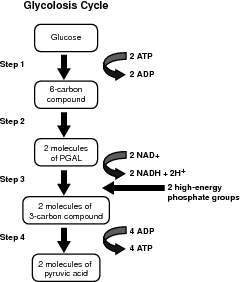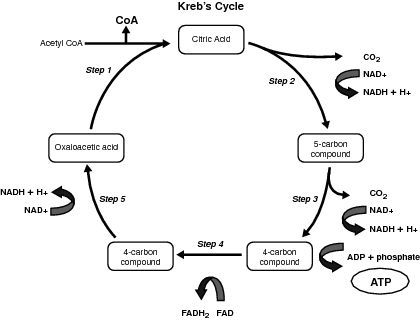Specialized Cell Structure and Function: Cellular Respiration
Cellular Respiration
Cellular respiration harvests the energy created during photosynthesis through a series of biochemical reactions:
- Glycolysis
- Kreb's cycle
- Electron transport chain
- Fermentation
Bionote
Historically it is thought that glycolysis was the first method of energy generation by early-Earth organisms because of the availability of glucose and the lack of an oxygen environment.
Glycolysis
Cells harvest the energy contained in the chemical bonds of glucose in a very controlled, step-by-step series of reactions that release small amounts of energy during each biochemical reaction. Glycolysis is the first step of cellular respiration, where a molecule of glucose is split to release energy.
The process of glycolysis is an enzyme controlled, four-step reaction that occurs in the cytoplasm of the cells:
- Energy is required to begin the process, so a molecule of glucose accepts two high-energy phosphate groups from two ATP molecules.
- The resulting intermediary molecule immediately divides into two, three-carbon molecules called PGAL, each containing a high-energy phosphate group.
- A second high-energy phosphate group is added to the three-carbon PGAL molecule and two NADH molecules are produced.
- Finally, the three-carbon PGAL molecules donate their high-energy phosphate to create ATP and the three-carbon pyruvate forms as the final products.
Refer to the illustration Glycolysis to view the action of the intermediary compounds and the energy molecules.

The high-energy phosphate groups added in Steps 1 and 3 are removed in Step 4 to create four ATP (two from Step 1 and two from Step 3) from four ADP. Because two ATP molecules were required to begin glycolysis and four were produced in the final step, the net gain is two ATP molecules. Although ATP is produced, glycolysis does not produce enough energy to sustain their life cycles for complex life forms. Therefore, the main purpose of glycolysis is to produce high-energy electrons for use in the electron transport chain. The final product, pyruvate or pyruvic acid, still contains energy that can be harvested in two ways depending on the availability of oxygen.
Kreb's Cycle
If oxygen is present, pyruvate undergoes aerobic respiration, which consists of two parts: the Kreb's cycle (also known as the citric acid cycle), and the electron transport chain. Following glycolysis, pyruvate moves from the cytoplasm into the mitochondria and reacts with a coenzyme to create the two-carbon molecule, acetyl coenzyme A (acetyl CoA) by losing one carbon dioxide molecule. Nine enzyme-controlled reactions are condensed and presented in the following five steps:

- Acetyl CoA donates the two-carbon acetyl group to a four-carbon intermediary compound, oxaloacetic acid, to create the six-carbon citric acid molecule.
- The high-energy electrons are oxidized to create the energy-rich NADH molecule when the six-carbon compound loses a carbon dioxide molecule to become a five-carbon molecule.
- A second molecule of NADH and a molecule of ATP are produced when another carbon dioxide molecule is released from the five-carbon molecule, which then degrades to a new four-carbon molecule.
- The four-carbon molecule is further oxidized to transfer high-energy electrons to create the high-energy compound, FADH2, and more NADH.
- Enzymes rearrange bonding within the four-carbon molecule to become oxaloacetic acid, which combines with the acetyl CoA to restart the Kreb's cycle.
Refer to the illustration Kreb's cycle to see the breakdown of the energy-containing molecules.
In summary, the Kreb's cycle removes carbon dioxide molecules from glucose in a stepwise fashion to release energy, but like glycolysis, the primary purpose is to create the high-energy electron carriers NADH and FADH2. The carbon dioxide expelled in the process is a waste product and must be removed from the system. For example, this is why you exhale.
Bioterms
The electron transport chain is a series of molecules called cytochromes and associated enzymes that pass high-energy electrons from molecule to molecule, removing energy in a stepwise mechanism. The last acceptor of the now energy-depleted electron is oxygen, which then combines with the excess hydrogen ions from the cytoplasm to create water. This is why you inhale.
The Kreb's cycle produces 10 ATP molecules and generates the energy molecules NADH and FADH2, which are harvested later in the electron transport chain.
At the conclusion of the Kreb's cycle, the original glucose molecule is completely oxidized, so most of the energy now resides in the high-energy electrons removed from the carbon-carbon and carbon-hydrogen bonds that created the electron carriers NADH and FADH2. The high-energy electrons contained in NADH and FADH2 are donated to the electron acceptor molecules located on the long folds of cristae on the inner membrane of the mitochondria. They begin the process of ATP formation in the electron transport chain.
Electron Transport Chain
The electron transport chain is where most of the energy is released in cellular respiration. The mechanism of the electron transport chain can be described in five steps:
- High-energy electrons from NADH and FADH2 enter the electron transport chain and are passed from molecule to molecule, losing energy in a controlled stepwise manner.
- The energy lost from the electrons is used to pump hydrogen ions from the inner mitochondrial compartment to the outer mitochondrial compartment across the mitochondrial membrane. This creates an area of high hydrogen ion concentration on one side of the mitochondrial membrane and a low hydrogen ion concentration on the other side of the membrane. The result is a concentration gradient across the inner membrane creating a source of potential energy, which is again comparable to the potential energy of water held back by a giant dam.
- The concentration gradient is used as a source of potential energy to drive the chemiosmotic synthesis of ATP.
- A carrier protein helps the hydrogen ions diffuse through a channel protein opening in the membrane. As the hydrogen ions diffuse from the area of high concen-tration to the area of low concentration, the carrier protein harnesses the kinetic energy of the hydrogen ion to add a high-energy phosphate group to ADP forming ATP, with the help of the enzyme ATP synthetase.
- The high-energy electron is passed along the electron transport chain until the excess energy is removed and then it is combined with the excess hydrogen ions and oxygen to form water, which then becomes a waste and must be removed from the system. For example, this is why you urinate.
In summary, the oxidation of glucose is approximately 37 percent efficient and produces all the energy required for almost every type of cell. The complete aerobic respiration of 1 molecule of glucose creates a maximum yield of 36 ATP molecules, as follows:
- Glycolysis = 4 ATP molecules
- Kreb's cycle = 10 ATP
- Electron transport chain = 22 ATP
Fermentation
If oxygen is not present after glycolysis, the electron transport chain cannot operate because there is no oxygen present to serve as the final electron acceptor. So the pyruvate is converted by certain specialized cells into other compounds in a process called fermentation. Fermentation does not produce additional ATP, but it does regenerate NAD+, which can then participate in glycolysis to make more ATP. The NADH is converted to NAD+ by adding the extra high-energy electron in NADH to an intermediate organic molecule. The combined total of glycolysis and fermentation produces 2 ATP molecules for every glucose, compared with 36 ATP via aerobic respiration. Although there are several fermentation pathways, the two most common produce lactic acid and ethanol.
In the enzyme-catalyzed lactic acid fermentation, the three-carbon pyruvate is rearranged into the three-carbon molecule lactate, a.k.a. lactic acid. In the process, NADH is oxidized to NAD+, which is then available for use in glycolysis, while pyruvate is reduced to lactate. This process is familiar to athletes because excess lactic acid buildup due to anaerobic exercise (not receiving enough oxygen), causes painful areas in the affected muscles.
Alcohol fermentation produces ethanol, also known as ethyl alcohol, the alcoholic component of adult alcoholic beverages. This two-stage process begins when pyruvate loses a carbon dioxide molecule to become an intermediary two-carbon molecule. In Step 2, the hydrogen ions from NADH are added to create ethyl alcohol and regenerate the NAD+.
Excerpted from The Complete Idiot's Guide to Biology © 2004 by Glen E. Moulton, Ed.D.. All rights reserved including the right of reproduction in whole or in part in any form. Used by arrangement with Alpha Books, a member of Penguin Group (USA) Inc.
To order this book direct from the publisher, visit the Penguin USA website or call 1-800-253-6476. You can also purchase this book at Amazon.com and Barnes & Noble.







